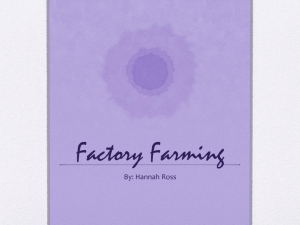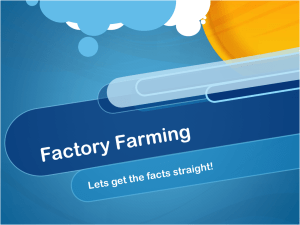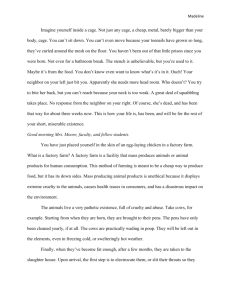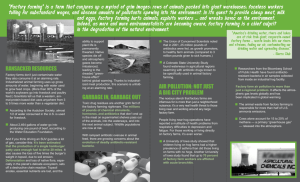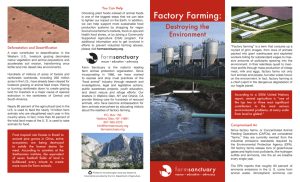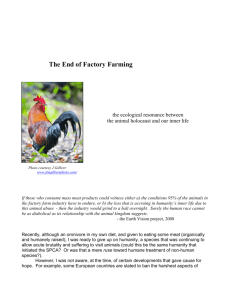ENVIRONMENT - Farm Sanctuary
advertisement
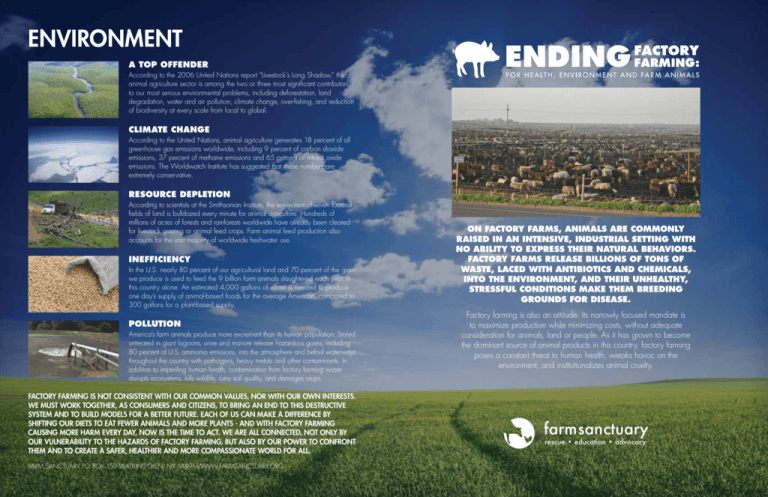
Environment A Top Offender According to the 2006 United Nations report “Livestock’s Long Shadow,” the animal agriculture sector is among the two or three most significant contributors to our most serious environmental problems, including deforestation, land degradation, water and air pollution, climate change, over-fishing, and reduction of biodiversity at every scale from local to global. Climate Change According to the United Nations, animal agriculture generates 18 percent of all greenhouse gas emissions worldwide, including 9 percent of carbon dioxide emissions, 37 percent of methane emissions and 65 percent of nitrous oxide emissions. The Worldwatch Institute has suggested that these numbers are extremely conservative. Resource Depletion According to scientists at the Smithsonian Institute, the equivalent of seven football fields of land is bulldozed every minute for animal agriculture. Hundreds of millions of acres of forests and rainforests worldwide have already been cleared for livestock grazing or animal feed crops. Farm animal feed production also accounts for the vast majority of worldwide freshwater use. Inefficiency In the U.S. nearly 80 percent of our agricultural land and 70 percent of the grain we produce is used to feed the 9 billion farm animals slaughtered each year in this country alone. An estimated 4,000 gallons of water is needed to produce one day’s supply of animal-based foods for the average American, compared to 300 gallons for a plant-based supply. Pollution America’s farm animals produce more excrement than its human population. Stored untreated in giant lagoons, urine and manure release hazardous gases, including 80 percent of U.S. ammonia emissions, into the atmosphere and befoul waterways throughout the country with pathogens, heavy metals and other contaminants. In addition to imperiling human health, contamination from factory farming waste disrupts ecosystems, kills wildlife, ruins soil quality, and damages crops. Factory farming is not consistent with our common values, nor with our own interests. We must work together, as consumers and citizens, to bring an end to this destructive system and to build models for a better future. Each of us can make a difference by shifting our diets to eat fewer animals and more plants - and with factory farming causing more harm every day, now is the time to act. We are all connected, not only by our vulnerability to the hazards of factory farming, but also by our power to confront them and to create a safer, healthier and more compassionate world for all. Farm Sanctuary PO Box 150 Watkins Glen, NY 14891 www.farmsanctuary.org On factory farms, animals are commonly raised in an intensive, industrial setting with no ability to express their natural behaviors. Factory farms release billions of tons of waste, laced with antibiotics and chemicals, into the environment, and their unhealthy, stressful conditions make them breeding grounds for disease. Factory farming is also an attitude. Its narrowly focused mandate is to maximize production while minimizing costs, without adequate consideration for animals, land or people. As it has grown to become the dominant source of animal products in this country, factory farming poses a constant threat to human health, wreaks havoc on the environment, and institutionalizes animal cruelty. farm sanctuary rescue • education • advocacy Public Health Animals Antibiotic Resistance Genetic Manipulation Due to extreme crowding, filth and the absence of individual veterinary care, animals on factory farms are highly susceptible to disease. Producers offset this risk through the routine use of antibiotics; in fact, approximately 70 percent of all antibiotics used in the U.S. every year are fed to farm animals—not because they are sick, but to make them grow more quickly or because the conditions in which they’re confined would otherwise kill massive numbers of them. This practice, condemned by such authorities as the American Medical Association and the American Academy of Pediatrics, has contributed to the emergence of virulent supergerms that are resistant to antibiotics. Industrialized farms have selectively bred animals to grow faster, to become larger, and to produce more milk and eggs than their systems can sustain. Chickens raised for meat now grow so rapidly that their hearts, lungs and bones are not developed well enough to support the remainder of their bodies, resulting in crippling deformities and heart attacks. They grow so unnaturally fast that their bodies mature to an adult weight and they are slaughtered at just 42 days old, when they are still vocalizing the peeps of a baby chick. To put this growth rate into perspective, the University of Arkansas Division of Agriculture reports, “If you grew as fast as a chicken, you’d weigh 349 pounds at age 2.” Zoonotic Diseases Mutilations Factory farms have been the breeding grounds of several zoonoses, diseases communicable from animals to humans, including mad cow disease, bird flu, swine flu, and a variant strain of MRSA (Methicillinresistant Staphylococcus aureus). The outbreaks of bird flu and swine flu in recent years have heightened epidemiologists’ fears of a human influenza pandemic. In the factory farming industry, producers sear off the beaks of hens and cut the toes of turkeys to mitigate fighting among intensively confined birds. The tails of pigs and cattle are chopped off without pain relief, forcing animals into greater conformity with an unnatural environment. Food-Borne Illness In the U.S. alone, the Centers for Disease Control and Prevention estimates that food-borne pathogens are responsible for over 76 million episodes of illness, 325,000 hospitalizations and 5,000 deaths each year. Food-borne pathogens such as E.coli and Salmonella can be traced directly to the high-intensity production practices of industrialized animal agriculture. Rural Communities Factory farms produce noxious gases, massive amounts of dust and may circumvent water pollution limits by spraying liquid manure from their cesspools into the air. Research has implicated long-term exposure to such contaminants in persistent respiratory problems such as asthma as well as increased hospitalizations and even premature death in communities near factory farm facilities. Obesity, Diabetes, Heart Disease and Cancer Through its intensive production practices and the help of government subsidies, factory farming provides the public with massive amounts of “cheap” meat, eggs and dairy, which has led to an increase in the consumption of these foods. These changes in the standard American diet are a major contributor to the obesity epidemic in the U.S., along with the incidence of chronic diseases such as diabetes, heart disease and cancer. Obesity and diet-related diseases increase America’s health care bill by billions of dollars each year. Intensive Confinement Hundreds of millions of animals spend their entire lives in enclosures that prevent them from lying down, turning around, extending their wings, or stretching their limbs comfortably – or at all. The majority of sows raised to produce piglets for the pork industry spend their lives inside 2-foot-wide metal gestation crates. Almost all hens raised for egg laying live crowded together in wire battery cages, with each bird allotted an area smaller than a standard piece of printer paper. The animals are driven insane and exhibit neurotic behaviors such as bar biting and head swinging. Factory Life Even farm animals not confined to crates or cages typically endure overcrowding, along with filthy pens, acrid air, disease, injury, and neglect. They are denied the freedom to explore, build nests, lie in the sun, form social groups, and care for their young. Tens of millions of laying hens are even denied light and adequate food for up to 12 days to force them into another laying cycle. These intelligent, instinctive, social, and emotional animals are terrified, stressed and frustrated, and they know no relief. Transport and Slaughter While still young, though in most cases already physically and psychologically exhausted, farm animals are loaded onto transport trucks for harrowing journeys to the stockyard or slaughterhouse. For some, this trip is the last straw. They collapse and become “downed,” unable to stand on their own. These vulnerable animals are often kicked, shocked and prodded onto auction or kill floors, if not left to die slowly. Chickens and turkeys are excluded from the Humane Slaughter Act and will not even be stunned before their slaughter. More than 9 billion land animals are slaughtered in the U.S. every year, 99 percent of whom are chickens and turkeys.
